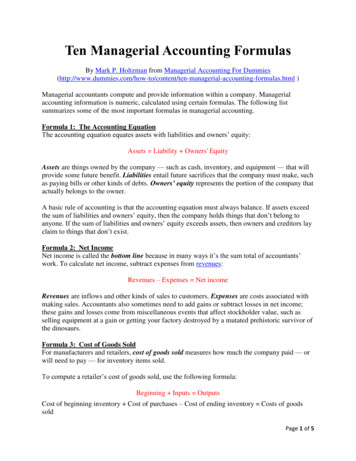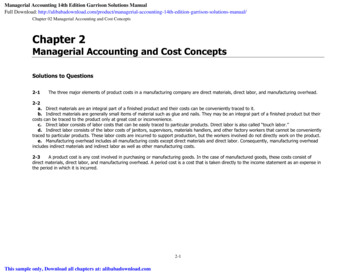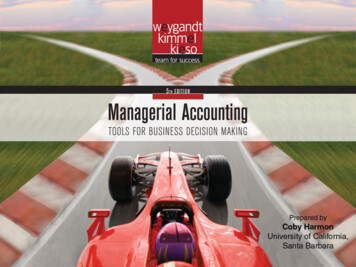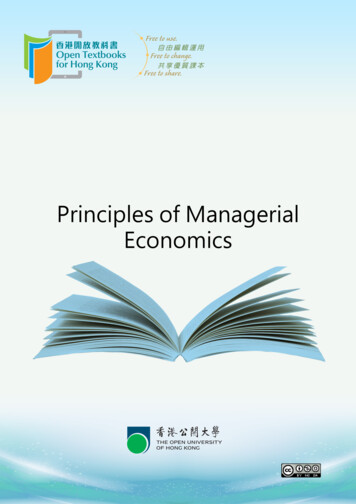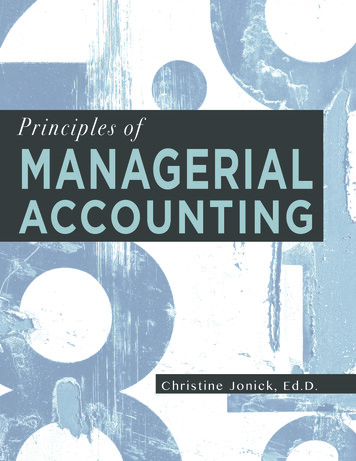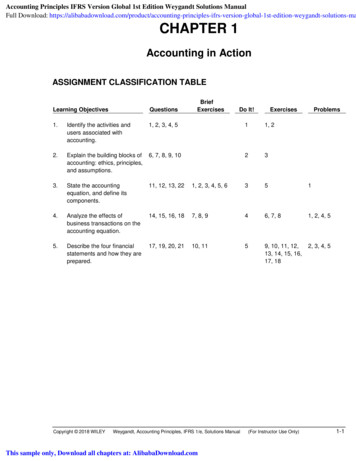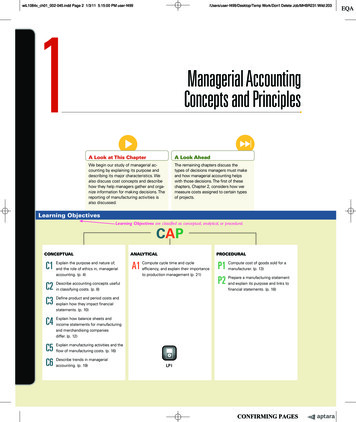
Transcription
wiL1084x ch01 002-045.indd Page 2 1/3/11 5:15:00 PM user-f499/Users/user-f499/Desktop/Temp Work/Don't Delete Job/MHBR231:Wild:2031Managerial AccountingConcepts and PrinciplesA Look at This ChapterA Look AheadWe begin our study of managerial accounting by explaining its purpose anddescribing its major characteristics. Wealso discuss cost concepts and describehow they help managers gather and organize information for making decisions. Thereporting of manufacturing activities isalso discussed.The remaining chapters discuss thetypes of decisions managers must makeand how managerial accounting helpswith those decisions. The first of thesechapters, Chapter 2, considers how wemeasure costs assigned to certain typesof projects.Learning ObjectivesLearning Objectives are classified as conceptual, analytical, or procedural.CAPCONCEPTUALC1Explain the purpose and nature of,and the role of ethics in, managerialaccounting. (p. 4)C2C3Describe accounting concepts usefulin classifying costs. (p. 8)C4Explain how balance sheets andincome statements for manufacturingand merchandising companiesdiffer. (p. 12)C5C6Explain manufacturing activities and theflow of manufacturing costs. (p. 16)ANALYTICALA1PROCEDURALCompute cycle time and cycleefficiency, and explain their importanceto production management (p. 21)Define product and period costs andexplain how they impact financialstatements. (p. 10)Describe trends in managerialaccounting. (p. 19)LP1P1P2Compute cost of goods sold for amanufacturer. (p. 13)Prepare a manufacturing statementand explain its purpose and links tofinancial statements. (p. 18)
wiL1084x ch01 002-045.indd Page 3 1/1/11 12:38:50 PM user-f499/Users/user-f499/Desktop/Temp Work/Don't Delete Job/MHBR231:Wild:203Decision InsightA Decision Feature launches each chapter showing the relevance of accounting for a real entrepreneur. AnEntrepreneurial Decision problem at the end of the assignments returns to this feature with a mini-case.Hot Late NightsCOLUMBIA, MO—Hanging out in a friend’s basement onenight, college students Corey Rimmel, Adam Hendin, and DavidMelnick thought a late-night bakery would be the perfect recipefor their hunger. But the enterprising trio’s thoughts weren’t juston eating cookies but also on starting a business. “At first wewere just joking, kicking the idea around,” Corey says. “Beforelong, we were in the library every night doing research. One daywe said, ‘Well, let’s just see if we can do it.’” After weeks of research, talking to entrepreneurs, writing a business plan, andsetting up a managerial accounting system, the friends startedHot Box Cookies (HotBoxCookies.com).Hot Box Cookies focuses on meeting individual customer’stastes. Starting with homemade dough in four flavors, the company’s bakers mix in whatever the customer wants—chocolatechips, Reese’s pieces, candy bars. After placing their orders,customers can play board games or surf the Internet in the HotBox store or have their fresh cookies delivered. The owners saytheir biggest surprise is how incredibly busy they were from thevery beginning of their business. “We haven’t had time to workour way through our marketing plan . . . we’ve just been toobusy,” explains Corey.The owners insist college is a great time to start a new business. Risk is low, and “if the owners are passionate and have a“I didn’t know I was a baker . . .”—COREY RIMMELgood plan, banks will lend money to get the business going,”says Corey. “It’s nice having something to call our own,” Adamsays. “A lot of people want to own a business, but they don’t.”But the trio, two of whom are accounting majors, emphasizethat understanding basic managerial principles, product and period costs, manufacturing statements, and cost flow is crucial.The owners use managerial accounting information from thebaking process to monitor and control costs and to assess whatcookies are most popular and profitable. Success has enabledthe business to expand and grow into other product lines suchas catering, coffee, and “Dough on the Go” sold in localmarkets.Corey, Adam, and David believe that entrepreneurs fill a voidby creating a niche. “I’ve always had it in my mind that I wouldwork for myself,” says Corey. However, financial success depends on monitoring and controlling operations to best meetcustomer needs. By staying focused and applying sound managerial accounting principles and concepts to their business, theowners hope to expand to other college campuses across thecountry. Ah, the sweet smell of success.[Sources: Hot Box Cookies Website, January 2011; Columbia Missourian,October 2008; The MOVE Magazine, October 2008; Columbia BusinessTimes, August 2008; Columbia Tribune, November 2008.]
wiL1084x ch01 002-045.indd Page 4 1/1/11 12:38:59 PM user-f499/Users/user-f499/Desktop/Temp Work/Don't Delete Job/MHBR231:Wild:203Chapter PreviewA Preview opens each chapter with a summary of topics covered.Managerial accounting, like financial accounting, provides information to help users make better decisions. However, managerial accounting and financial accounting differ in important ways,which this chapter explains. This chapter also compares the accounting and reporting practices used by manufacturing and merchandising companies. A merchandising company sells productswithout changing their condition. A manufacturing company buysraw materials and turns them into finished products for sale tocustomers. A third type of company earns revenues by providingservices rather than products. The skills, tools, and techniquesdeveloped for measuring a manufacturing company’s activitiesapply to service companies as well. The chapter concludes byexplaining the flow of manufacturing activities and preparing themanufacturing statement.Managerial Accounting Concepts and PrinciplesManagerialAccounting Basics Managerial CostConceptsPurpose of managerial accountingNature of managerial accountingManagerial decisionsFraud and ethics in managerialaccounting Types of cost classificationsIdentification of costclassificationsCost concepts for servicecompaniesReportingManufacturing Activities Balance sheetIncome statementFlow of activitiesManufacturing statementTrends in managerialaccountingMANAGERIAL ACCOUNTING BASICSKey terms are printed in bold anddefined again in the end-of-bookglossary.Managerial accounting is an activity that provides financial and nonfinancial information to anorganization’s managers and other internal decision makers. This section explains the purposeof managerial accounting (also called management accounting) and compares it with financialaccounting. The main purpose of the financial accounting system is to prepare general-purposefinancial statements. That information is incomplete for internal decision makers who manageorganizations.Purpose of Managerial AccountingC1Explain the purpose andnature of, and the role ofethics in, managerialaccounting.Point: Nonfinancial information, alsocalled nonmonetary information, includescustomer and employee satisfaction data,the percentage of on-time deliveries, andproduct defect rates.Point: Costs are important to managers because they impact both the financial position and the profitability of abusiness. Managerial accounting assists inanalysis, planning, and control of costs.The purpose of both managerial accounting and financial accounting is providing useful information to decision makers. They do this by collecting, managing, and reporting information indemand by their users. Both areas of accounting also share the common practice of reportingmonetary information, although managerial accounting includes the reporting of nonmonetaryinformation. They even report some of the same information. For instance, a company’s financial statements contain information useful for both its managers (insiders) and other personsinterested in the company (outsiders).The remainder of this book looks carefully at managerial accounting information, how togather it, and how managers use it. We consider the concepts and procedures used to determinethe costs of products and services as well as topics such as budgeting, break-even analysis,product costing, profit planning, and cost analysis. Information about the costs of products andservices is important for many decisions that managers make. These decisions include predicting the future costs of a product or service. Predicted costs are used in product pricing, profitability analysis, and in deciding whether to make or buy a product or component. More generally,much of managerial accounting involves gathering information about costs for planning andcontrol decisions.Planning is the process of setting goals and making plans to achieve them. Companies formulate long-term strategic plans that usually span a 5- to 10-year horizon and then refine themwith medium-term and short-term plans. Strategic plans usually set a firm’s long-term directionby developing a road map based on opportunities such as new products, new markets, and capital investments. A strategic plan’s goals and objectives are broadly defined given its long-term
wiL1084x ch01 002-045.indd Page 5 1/1/11 12:39:00 PM user-f499/Users/user-f499/Desktop/Temp Work/Don't Delete Job/MHBR231:Wild:203Chapter 1 Managerial Accounting Concepts and Principles5orientation. Medium- and short-term plans are more operational in nature. They translate thestrategic plan into actions. These plans are more concrete and consist of better defined objectives and goals. A short-term plan often covers a one-year period that, when translated inmonetary terms, is known as a budget.Control is the process of monitoring planning decisions and evaluating an organization’sactivities and employees. It includes the measurement and evaluation of actions, processes, andoutcomes. Feedback provided by the control function allows managers to revise their plans.Measurement of actions and processes also allows managers to take corrective actions to avoidundesirable outcomes. For example, managers periodically compare actual results with plannedresults. Exhibit 1.1 portrays the important management functions of planning and control.EXHIBIT 1.1MonitoringPlanning and Control (includingmonitoring and feedback)PlanningControl Strategic aims Long- & short-term Annual budgets Measurement Evaluation OversightInfographics reinforce keyconcepts through visual learning.FeedbackManagers use information to plan and control business activities. In later chapters, we explainhow managers also use this information to direct and improve business operations.Nature of Managerial AccountingManagerial accounting has its own special characteristics. To understand these characteristics,we compare managerial accounting to financial accounting; they differ in at least seven important ways. These differences are summarized in Exhibit 1.2. This section discusses each of thesecharacteristics.EXHIBIT 1.2"This departmentis doing well.We'll expand itsproduct line.""This company'soutlook is good.I'll buy itsshares."Financial AccountingManagerial AccountingInvestors, creditors, and other usersexternal to the organizationManagers, employees, and decisionmakers internal to the organizationAssist external users in makinginvestment, credit, and other decisionsAssist managers in making planningand control decisionsStructured and often controlled by GAAPRelatively flexible (no GAAP constraints)Often available only after an audit iscompleteAvailable quickly without the need towait for an auditFocus on historical information with somepredictionsMany projections and estimates;historical information also presented6. Focus of informationEmphasis on whole organizationEmphasis on an organization’sprojects, processes, and subdivisions7. Nature of informationMonetary informationMostly monetary; but also nonmonetaryinformation1. Users and decision makers2. Purpose of information3. Flexibility of practice4. Timeliness of information5. Time dimensionKey Differences betweenManagerial Accounting andFinancial Accounting
wiL1084x ch01 002-045.indd Page 6 1/1/11 12:39:00 PM user-f4996/Users/user-f499/Desktop/Temp Work/Don't Delete Job/MHBR231:Wild:203Chapter 1 Managerial Accounting Concepts and PrinciplesCompanies accumulate, process, and report financial accounting and managerial accounting information for different groups of decision makers. Financial accounting information is provided primarily to external users including investors, creditors,analysts, and regulators. External users rarely have a major role in managing a company’s dailyactivities. Managerial accounting information is provided primarily to internal users who are responsible for making and implementing decisions about a company’s business activities.Users and Decision MakersPoint: It is desirable to accumulatecertain information for managementreports in a database separate fromfinancial accounting records.Margin notes further enhancethe textual material.Investors, creditors, and other external users of financial accounting information must often decide whether to invest in or lend to a company. If they havealready done so, they must decide whether to continue owning the company or carrying the loan.Internal decision makers must plan a company’s future. They seek to take advantage of opportunities or to overcome obstacles. They also try to control activities and ensure their effective and efficient implementation. Managerial accounting information helps these internal users make bothplanning and control decisions.Purpose of InformationFlexibility of Practice External users compare companies by using financial reports andPoint: The Institute of Management Accountants issues statements that governthe practice of managerial accounting.Accountants who pass a qualifying examare awarded the CMA.need protection against false or misleading information. Accordingly, financial accounting relies on accepted principles that are enforced through an extensive set of rules and guidelines, orGAAP. Internal users need managerial accounting information for planning and controlling theircompany’s activities rather than for external comparisons. They require different types of information depending on the activity. This makes standardizing managerial accounting systemsacross companies difficult. Instead, managerial accounting systems are flexible. The design of acompany’s managerial accounting system depends largely on the nature of the business and thearrangement of its internal operations. Managers can decide for themselves what informationthey want and how they want it reported. Even within a single company, different managers often design their own systems to meet their special needs. The important question a managermust ask is whether the information being collected and reported is useful for planning, decisionmaking, and control purposes.Timeliness of Information Formal financial statements reporting past transactions andPoint: Financial statements are usuallyissued several weeks after the periodend. GAAP requires the reporting ofimportant events that occur while thestatements are being prepared. Theseevents are called subsequent events.Point: Independent auditors test theintegrity of managerial accountingrecords when they are used in preparingfinancial statements.events are not immediately available to outside parties. Independent certified public accountantsoften must audit a company’s financial statements before it provides them to external users.Thus, because audits often take several weeks to complete, financial reports to outsiders usuallyare not available until well after the period-end. However, managers can quickly obtain managerial accounting information. External auditors need not review it. Estimates and projections areacceptable. To get information quickly, managers often accept less precision in reports. As anexample, an early internal report to management prepared right after the year-end could reportnet income for the year between 4.2 and 4.8 million. An audited income statement could latershow net income for the year at 4.6 million. The internal report is not precise, but its information can be more useful because it is available earlier.Internal auditing plays an important role in managerial accounting. Internal auditors evaluatethe flow of information not only inside but also outside the company. Managers are responsiblefor preventing and detecting fraudulent activities in their companies.To protect external users from false expectations, financial reports dealprimarily with results of both past activities and current conditions. While some predictionssuch as service lives and salvage values of plant assets are necessary, financial accounting avoidspredictions whenever possible. Managerial accounting regularly includes predictions of conditions and events. As an example, one important managerial accounting report is a budget, whichpredicts revenues, expenses, and other items. If managerial accounting reports were restricted tothe past and present, managers would be less able to plan activities and less effective in managing and evaluating current activities.Time DimensionEXHIBIT 1.3Focus of External ReportsCompanyPerformanceFocus of Information Companies often organize into divisions and departments, but inves-tors rarely can buy shares in one division or department. Nor do creditors lend money to a company’s single division or department. Instead, they own shares in or make loans to the entire company.Financial accounting focuses primarily on a company as a whole as depicted in Exhibit 1.3. The
wiL1084x ch01 002-045.indd Page 7 1/3/11 5:15:10 PM user-f499/Users/user-f499/Desktop/Temp Work/Don't Delete Job/MHBR231:Wild:203Chapter 1 Managerial Accounting Concepts and Principlesfocus of managerial accounting is different. While top-level managers are responsible for managingthe whole company, most other managers are responsible for much smaller sets of activities. Thesemiddle-level and lower-level managers need managerial accounting reports dealing with specificactivities, projects, and subdivisions for which they are responsible. For instance, division salesmanagers are directly responsible only for the results achieved in their divisions. Accordingly, division sales managers need information about results achieved in their own divisions to improve theirperformance. This information includes the level of success achieved by each individual, product,or department in each division as depicted in Exhibit 1.4.7EXHIBIT 1.4Focus of Internal ReportsProductPerformanceNature of Information Both financial and managerial accounting systems reportmonetary information. Managerial accounting systems also report considerable nonmonetaryinformation. Monetary information is an important part of managerial decisions, and nonmonetary information plays a crucial role, especially when monetary effects are difficult to measure.Common examples of nonmonetary information are the quality and delivery criteria of purchasing decisions.Decision EthicsAnswer — p. 27Production Manager You invite three friends to a restaurant. When the dinner check arrives, David, aself-employed entrepreneur, picks it up saying, “Here, let me pay. I’ll deduct it as a business expense onmy tax return.” Denise, a salesperson, takes the check from David’s hand and says, “I’ll put this on mycompany’s credit card. It won’t cost us anything.” Derek, a factory manager for a company, laughs andsays, “Neither of you understands. I’ll put this on my company’s credit card and call it overhead on a costplus contract my company has with a client.” (A cost-plus contract means the company receives its costsplus a percent of those costs.) Adds Derek, “That way, my company pays for dinner and makes a profit.”Who should pay the bill? Why? Managerial Decision MakingThe previous section emphasized differences between financial and managerial accounting, but they are not entirely separate. Similar information isuseful to both external and internal users. For instance, information aboutcosts of manufacturing products is useful to all users in making decisions.Also, both financial and managerial accounting affect peoples’ actions. Forexample, Trek’s design of a sales compensation plan affects the behavior ofits salesforce when selling its manufactured bikes. It also must estimate thedual effects of promotion and sales compensation plans on buying patternsof customers. These estimates impact the equipment purchase decisions formanufacturing and can affect the supplier selection criteria established bypurchasing. Thus, financial and managerial accounting systems do more thanmeasure; they also affect people’s decisions and actions.Fraud and Ethics in Managerial AccountingFraud, and the role of ethics in reducing fraud, are important factors in running businessoperations. Fraud involves the use of one’s job for personal gain through the deliberate misuse of the employer’s assets. Examples include theft of the employer’s cash or other assets,overstating reimbursable expenses, payroll schemes, and financial statement fraud. Fraudaffects all business and it is costly: A 2008 Report to the Nation from the Association ofCertified Fraud Examiners estimates the average U.S. business loses 7% of its annual revenues to fraud.The most common type of fraud, where employees steal or misuse the employer’s resources,results in an average loss of 175,000 per occurrence. For example, in a billing fraud, an employee sets up a bogus supplier. The employee then prepares bills from the supplier and paysthese bills from the employer’s checking account. The employee cashes the checks sent to thebogus supplier and uses them for his or her own personal benefit.Decision Ethics boxes are roleplaying exercises that stress ethics inaccounting and business.
wiL1084x ch01 002-045.indd Page 8 1/1/11 12:39:04 PM user-f4998/Users/user-f499/Desktop/Temp Work/Don't Delete Job/MHBR231:Wild:203Chapter 1 Managerial Accounting Concepts and PrinciplesMore generally, although there are many types of fraud schemes, all fraud: Is done to provide direct or indirect benefit to the employee.Violates the employee’s obligations to the employer.Costs the employer money or loss of other assets.Is hidden from the employer.Implications for Managerial Accounting Fraud increases a business’s costs. Leftundetected, these inflated costs can result in poor pricing decisions, an improper product mix,and faulty performance evaluations. Management can develop accounting systems to closelytrack costs and identify deviations from expected amounts. In addition, managers rely on aninternal control system to monitor and control business activities. An internal control systemis the policies and procedures managers use to: Point: The IMA also issues the Certified Management Accountant (CMA) andthe Certified Financial Manager (CFM)certifications. Employees with the CMAor CFM certifications typically earnhigher salaries than those without.Point: The Sarbanes-Oxley Actrequires each issuer of securities todisclose whether it has adopted a codeof ethics for its senior officers and thecontent of that code.Urge adherence to company policies.Promote efficient operations.Ensure reliable accounting.Protect assets.Combating fraud and other dilemmas requires ethics in accounting. Ethics are beliefs thatdistinguish right from wrong. They are accepted standards of good and bad behavior. Identifying the ethical path can be difficult. The preferred path is a course of action that avoids castingdoubt on one’s decisions.The Institute of Management Accountants (IMA), the professional association for management accountants, has issued a code of ethics to help accountants involved in solvingethical dilemmas. The IMA’s Statement of Ethical Professional Practice requires that management accountants be competent, maintain confidentiality, act with integrity, and communicateinformation in a fair and credible manner.The IMA provides a “road map” for resolving ethical conflicts. It suggests that an employeefollow the company’s policies on how to resolve such conflicts. If the conflict remains unresolved, an employee should contact the next level of management (such as the immediatesupervisor) who is not involved in the ethical conflict.Quick CheckAnswers — p. 281. Managerial accounting produces information (a) to meet internal users’ needs, (b) to meet aQuick Check is a chance tostop and reflect on key points.user’s specific needs, (c) often focusing on the future, or (d ) all of these.2. What is the difference between the intended users of financial and managerial accounting?3. Do generally accepted accounting principles (GAAP) control and dictate managerial accounting?MANAGERIAL COST CONCEPTSC2Describe accountingconcepts useful inclassifying costs.An organization incurs many different types of costs that are classified differently, depending onmanagement needs (different costs for different purposes). We can classify costs on the basis oftheir (1) behavior, (2) traceability, (3) controllability, (4) relevance, and (5) function. This sectionexplains each concept for assigning costs to products and services.Types of Cost ClassificationsClassification by Behavior At a basic level, a cost can be classified as fixed or variable. Afixed cost does not change with changes in the volume of activity (within a range of activityknown as an activity’s relevant range). For example, straight-line depreciation on equipment is afixed cost. A variable cost changes in proportion to changes in the volume of activity. Sales commissions computed as a percent of sales revenue are variable costs. Additional examples of fixed
wiL1084x ch01 002-045.indd Page 9 1/1/11 12:39:04 PM user-f499/Users/user-f499/Desktop/Temp Work/Don't Delete Job/MHBR231:Wild:203Chapter 1 Managerial Accounting Concepts and Principles9and variable costs for a bike manufacturer are provided in Exhibit 1.5. When cost items are combined, total cost can be fixed, variable, or mixed. Mixed refers to a combination of fixed and variable costs. Equipment rental often includes a fixed cost for some minimum amount and a variablecost based on amount of usage. Classification of costs by behavior is helpful in cost-volume-profitanalyses and short-term decision making. We discuss these in Chapters 5 and 10.EXHIBIT 1.5Fixed and Variable CostsFixed Cost: Rent for Rocky Mountain Bikes'building is 22,000, and it doesn't changewith the number of bikes produced.Variable Cost: Cost of bicycle tires isvariable with the number of bikesproduced—this cost is 15 per pair.Classification by Traceability A cost is often traced to a cost object, which is a product,process, department, or customer to which costs are assigned. Direct costs are those traceable to asingle cost object. For example, if a product is a cost object, its material and labor costs are usuallydirectly traceable. Indirect costs are those that cannot be easily and cost-beneficially traced to asingle cost object. An example of an indirect cost is a maintenance plan that benefits two or moredepartments. Exhibit 1.6 identifies examples of both direct and indirect costs for the maintenancedepartment in a manufacturing plant. Thus, salaries of Rocky Mountain Bikes’ maintenance department employees are considered indirect if the cost object is bicycles and direct if the cost object isthe maintenance department. Classification of costs by traceability is useful for cost allocation. Thisis discussed in Chapter 9.EXHIBIT 1.6Direct and Indirect Costs of aMaintenance DepartmentDirect Costs Salaries of maintenancedepartment employees Equipment purchasedby maintenancedepartment Materials purchasedby maintenancedepartment Maintenance departmentequipment depreciationDecision MakerIndirect Costs Factory accounting Factory administration Factory rent Factory manager'ssalary Factory light and heat Factory internal audit Factory intranet Insurance on factoryAnswer — p. 27Entrepreneur You wish to trace as many of your assembly department’s direct costs as possible. Youcan trace 90% of them in an economical manner. To trace the other 10%, you need sophisticated andcostly accounting software. Do you purchase this software? Classification by Controllability A cost can be defined as controllable or notcontrollable. Whether a cost is controllable or not depends on the employee’s responsibilities, as shown in Exhibit 1.7. This is referred toas hierarchical levels in management, or peckingorder. For example, investments in machineryare controllable by upper-level managers but notlower-level managers. Many daily operating exSupervisorpenses such as overtime often are controllable by Senior ManagerControls costs ofControls daily expenlower-level managers. Classification of costs by coninvestments inses such as supplies,trollability is especially useful for assigning respon- land, buildings,maintenance, andand equipment.sibility to and evaluating managers.overtime.Decision Maker boxes are roleplaying exercises that stress therelevance of accounting.EXHIBIT 1.7Controllability of Costs
wiL1084x ch01 002-045.indd Page 10 1/1/11 12:39:09 PM user-f49910Chapter 1 Managerial Accounting Concepts and PrinciplesPoint: Opportunity costs are notrecorded by the accounting system.C3/Users/user-f499/Desktop/Temp Work/Don't Delete Job/MHBR231:Wild:203Define product and periodcosts and explain howthey impact financialstatements.Point: Only costs of production andpurchases are classed as product costs.Point: Product costs are either in theincome statement as part of cost ofgoods sold or in the balance sheet asinventory. Period costs appear only onthe income statement under operatingexpenses. See Exhibit 1.8.Classification by Relevance A cost can be classified by relevance by identifying it aseither a sunk cost or an out-of-pocket cost. A sunk cost has already been incurred and cannot beavoided or changed. It is irrelevant to future decisions. One example
Managerial accounting is an activity that provides financial and nonfinancial information to an organization’s managers and other internal decision makers. This section explains the pur pose of managerial accounting (
